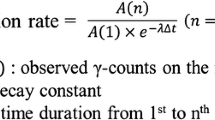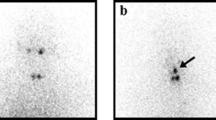Abstract
Purpose
Existence and cause of thyroid stunning was controversially discussed for decades but the underlying mechanism remains unclear. Numerous studies describe thyroid stunning in radioiodine-131 therapy (RIT) of differentiated thyroid carcinoma. However, there are no studies evaluating thyroid stunning in benign thyroid diseases caused by the radioiodine uptake test (RIUT). Therefore, the influence of pre-therapeutic tracer radiation dose on therapeutic iodine-131 uptake was evaluated retrospectively.
Methods
A total of 914 RIT patients were included. Exclusion criteria were anti-thyroid drugs, pre- and/or intra-therapeutic effective half-lives (EHL) beyond 8.04 days and externally performed RIUT or 24 h RIUT. All patients received RIUT 1 week before RIT. Thyroid volume was estimated via ultrasound. Tracer radiation dose to the thyroid was calculated retrospectively. The dependence of changes in the pre-therapeutic to the therapeutic extrapolated-maximum-131I-uptake (EMU) from the dose in RIUT was evaluated statistically.
Results
EMU in RIUT ranged from 0.10 to 0.82 (median: 0.35) and EMU in RIT ranged from 0.10 to 0.74 (median: 0.33). Averaged over the whole cohort the therapeutic EMU decreased significantly (2.3% per Gray intra-thyroidal tracer radiation dose). A disease-specific evaluation showed dose-dependent thyroid stunning from 1.2% per Gray in solitary toxic nodules (n = 327) to 21% per Gray in goiters (n = 135) which was significant for the subgroups of disseminated autonomies (n = 114), multifocal autonomies (n = 178) and goiters (p < 0.05) but not for Graves’ diseases (n = 160) and solitary toxic nodules (p > 0.05).
Conclusions
The presented data indicate for the first time a significant dependence of pre-therapeutic radiation dose on thyroid stunning in goiter and disseminated and multifocal autonomy. To achieve the desired intra-thyroidal radiation dose, RIT activity should be adapted depending on the dose in RIUT.

Similar content being viewed by others
References
R. Lorenz, A. Buck, C. Reiners, In-patient nuclear medicine therapy in Germany from 2010 to 2012 – analysis of structured quality reports. Nuklearmedizin 54, 61–68 (2015)
M. Freesmeyer, F. Gühne, C. Kühnel, T. Opfermann, T. Winkens, A. Werner Determination of effective half-life of 131I in patients with differentiated thyroid carcinoma: comparison of cystatin C and creatinine-based estimation of renal function. Endocrine (2018). https://doi.org/10.1007/s12020-018-1800-4
O. Dohan, A. de la Vieja, V. Paroder, C. Riedel, M. Artani, M. Reed, C.S. Ginter, N. Carrasco, The sodium/iodine symporter (NIS): characterization, regulation, and medical significance. Endocr. Rev. 24, 48–77 (2003)
E. Bell, F. Grünwald. Radiojodtherapie bei Benignen und Malignen Schilddrüsenerkrankungen (Springer-Verlag Berlin Heidelberg, New York, 1999).
R.W. Rawson, J.E. Rall, W. Peacock, Limitations in the treatment of cancer of the thyroid with radioactive iodine. Trans. Assoc. Am. Physicians 64, 179–198 (1951)
W. Brenner, Is thyroid stunning a real phenomenon or just fiction? J. Nucl. Med. 43, 835–836 (2002)
A.J. Coakley, Thyroid stunning. Eur. J. Nucl. Med. 25, 203–204 (1998)
H.Q. Dam, S.M. Kim, H.C. Lin, C.M. Intenzo, 131I therapeutic efficacy is not influenced by stunning after diagnostic whole-body scanning. Radiology 232, 527–533 (2004)
I.R. McDougall, A. Iagaru, Thyroid stunning: fact or fiction? Semin. Nucl. Med. 41, 105–112 (2011)
S.P. Cholewinski, K.S. Yoo, P.S. Klieger, R.E. O’Mara, Absence of thyroid stunning after diagnostic whole-body scanning with 185 MBq 131I. J. Nucl. Med. 41, 1198–1202 (2000)
M. Filesi, M. Colandrea, T. Montesano, R. D’Apollo, G. Ronga, Thyroid stunning in clinical practice: is it a real problem? Minerva Endocrinol. 34, 29–36 (2009)
J.M. Woolfenden, Thyroid stunning revisited. J. Nucl. Med. 47, 1403–1404 (2006)
J.E. Kalinyak, I.R. McDougall, Whole-body scanning with radionuclides of iodine, and the controversy of “thyroid stunning“. Nucl. Med. Commun. 25, 883–889 (2004)
S. Walrand, M. Hesse, F. Jamar, Statistical and radiobiological analysis of the so-called thyroid stunning. EJNMMI Res. 5, 67 (2015)
M. Lassmann, M. Luster, H. Hänscheid, C. Reiners, Impact of 131I diagnostic activities on the biokinetics of thyroid remnants. J. Nucl. Med. 45, 619–625 (2004)
L.F. Morris, A.D. Waxman, G.D. Braunstein, Thyroid stunning. Thyroid 13, 333–340 (2003).
J.P. Muratet, A. Daver, J.F. Minier, F. Larra, Influence of scanning doses of iodine-131 on subsequent first ablative treatment outcome in patients operated on for differentiated thyroid carcinoma. J. Nucl. Med. 39, 1546–1550 (1998)
P. Postgård, J. Himmelman, U. Lindencrona, N. Bhogal, D. Wiberg, G. Berg, S. Jansson, E. Nyström, E. Forssell-Aronsson, M. Nilsson, Stunning of iodide transport by 131I irradiation in cultured thyroid epithelial cells. J. Nucl. Med. 43, 828–834 (2002)
M.M. Nordén, F. Larsson, S. Tedelind, T. Carlsson, C. Lundh, E. Forssell-Aronsson, M. Nilsson, Down-regulation of the sodium/iodide symporter explains 131I-induced thyroid stunning. Cancer Res. 67, 7512–7517 (2007)
B. Meller, E. Gaspas, W. Deisting, B. Czarnocka, M. Baehre, B.E. Wenzel, Decreased radioiodine uptake of FRTL-5 cells after 131I incubation in vitro: molecular biological investigations indicate a cell cycle-dependent pathway. Eur. J. Nucl. Med. Mol. Imaging 35, 1204–1212 (2008)
C. Lundh, M.M. Nordén, M. Nilsson, E. Forssell-Aronsson, Reduced iodine transport (stunning) and DNA synthesis in thyrocytes exposed to low absorbed doses from 131I in vitro. J. Nucl. Med. 48, 481–486 (2007)
C. Lundh, U. Lindencrona, P. Postgård, T. Carlsson, M. Nilsson, E. Forssell-Aronsson, Radiation-induced thyroid stunning: differential effects of 123I, 131I, 99mTc and 211At on iodide transport and NIS mRNA expression in cultured thyroid cells. J. Nucl. Med. 50, 1161–1167 (2009)
F.A. Verburg, R.B. Verkooijen, M.P. Stokkel, J.W. van Isselt, The success of 131I ablation in thyroid cancer patients is significantly reduced after a diagnostic activity of 40 MBq 131I. Nuklearmedizin 48, 138–142 (2009)
J.C. Sisson, A.M. Avram, S.A. Lawson, P.G. Gauger, G.M. Doherty, The so-called stunning of thyroid tissue. J. Nucl. Med. 47, 1406–1412 (2006)
Y. Yin, Q. Mao, S. Chen, N. Li, X. Li, Y. Li, A quantitative study about thyroid stunning after diagnostic whole-body scanning with 74 MBq 131I in patients with differentiated thyroid carcinoma. Q. J. Nucl. Med. Mol. Imaging 59, 455–461 (2015)
T. Krohn, P.T. Meyer, C. Ocklenburg, D. Knollmann, B. Nowak, W.M. Schaefer, Stunning in radioiodine therapy of benign thyroid disease. Quantification and therapeutic relevance. Nuklearmedizin 47, 248–254 (2008)
O. Sabri, M. Zimny, M. Schreckenberger, A. Meyer-Oelmann, P. Reinartz, U. Buell, Does thyroid stunning exist? A model with benign thyroid disease. Eur. J. Nucl. Med. 27, 1591–1597 (2000)
E. Wudel, K. Koppenhagen, The stunned thyroid? Veränderte Radiojodkinetik der NACH-THERAPIE bei benignen Schilddrüsenerkrankungen. Nuklearmedizin 34, A166 (1995). (Abstract)
M. Dietlein, J. Dressler, W. Eschner, M. Lassmann, B. Leisner, C. Reiners, H. Schicha, Procedure guideline for radioiodine test (version 3). Nuklearmedizin 46, 198–202 (2007)
M. Dietlein, J. Dressler, F. Grünwald, B. Leisner, E. Moser, C. Reiners, H. Schicha, P. Schneider, O. Schober, Guideline for radioiodine therapy for benign thyroid disease (version 4). Nuklearmedizin 46, 220–223 (2007)
L.D. Marinelli, Dosage determination in the use of radioactive isotopes. J. Clin. Invest. 28, 1271–1280 (1949)
F.A. Leger, M. Izembart, F. Dagousset, L. Barritault, G. Baillet, A. Chevalier, J. Clerc, Decreased uptake of therapeutic doses of iodine-131 after 185-MBq iodine-131 diagnostic imaging for thyroid remnants in differentiated thyroid carcinoma. Eur. J. Nucl. Med. 25, 242–246 (1998)
H.M. Park, Y.H. Park, X.H. Zhou, Detection of thyroid remnant/metastasis without stunning: an ongoing dilemma. Thyroid 7, 277–280 (1997)
T.E. Hilditch, M.F. Dempsey, A.A. Bolster, R.M. McMenemin, N.S. Reed, Self-stunning in thyroid ablation: evidence from comparative studies of diagnostic 131I and 123I. Eur. J. Nucl. Med. 29, 783–788 (2002)
H.M. Park, O.W. Perkins, J.W. Edmondson, R.B. Schnute, A. Manatunga, Influence of diagnostic radioiodine on the uptake of ablative dose of iodine-131. Thyroid 4, 49–54 (1994)
H.S. Wu, H.H. Hseu, W.Y. Lin, S.J. Wang, Y.C. Liu, Decreased uptake after fractionated ablative doses of iodine-131. Eur. J. Nucl. Med. Mol. Imaging 32, 167–173 (2005)
H.W. Yeung, J.L. Humm, S.M. Larson, Radioiodine uptake in thyroid remnants during therapy after tracer dosimetry. J. Nucl. Med. 41, 1082–1085 (2000)
J.C. Reynolds, J. Robbins, The changing role of radioiodine in the management of differentiated thyroid cancer. Semin. Nucl. Med. 27, 153–164 (1997)
E.C.S.C. Etchebehere, A.O. Santor, P.S. Matos, L.V.M. Assumpçāo, Lima MCVL, M.C.L. Lima, L.S. Ward, Is thyroid stunning clinically relevant? A retrospective analysis of 208 patients. Arq. Bras. Endocrinol. Metab. 58, 292–300 (2014)
T. Bajén, S. Mañé, A. Muñoz, J.R. García, Effect of a diagnostic dose of 185 MBq 131I on postsurgical thyroid remnants. J. Nucl. Med. 41, 2038–2042 (2000)
I.R. McDougall, 74 MBq radioiodine 131I does not prevent uptake of therapeutic doses of 131I (i.e. it does not cause stunning) in differentiated thyroid cancer. Nucl. Med. Commun. 18, 505–512 (1997)
E.B. Silberstein, Comparison of outcomes after (123)I versus (131)I pre-ablation imaging before radioiodine ablation in differentiated thyroid carcinoma. J. Nucl. Med. 48, 1043–1046 (2007)
N.A. Damle, C. Bal, S. Ballal, Stunning in post (131)I therapy scans after low-dose (131)I diagnostic whole body scans with differentiated thyroid cancer in the Indian patient population: critical importance of interval between the two scans. Indian J. Endocrinol. Metab. 16, 477–478 (2012)
R.K. Jeevanram, D.H. Shah, S.M. Sharma, R.D. Ganatra, Influence of initial large dose on subsequent uptake of therapeutic radioiodine in thyroid cancer patients. Int. J. Rad. Appl. Instrum. B. 13, 277–279 (1986)
M. Medvedec, Thyroid stunning in vivo and in vitro. Nucl. Med. Commun. 26, 731–735 (2005)
J. Halstenberg, W.T. Kranert, H. Korkusuz, A. Mayer, H. Ackermann, F. Grünwald, C. Happel, Influence of glucocorticoid therapy on intratherapeutic biodistribution of 131I radioiodine therapy in Graves’ disease. Nuklearmedizin 57, 43–49 (2018)
M.K. Chen, M. Yasrebi, J. Samii, L.H. Staib, I. Doddamane, D.W. Cheng, The utility of I-123 pretherapy scan in I-131 radioiodine therapy for thyroid cancer. Thyroid 22, 304–309 (2012)
A. Siddiqi, R.R. Foley, K.E. Britton, A. Sibtain, P.N. Plowman, A.B. Grossman, J.P. Monson, G.M. Besser, The role of 123I-diagnostic imaging in the follow-up of patients with differentiated thyroid carcinoma as compared to 131I-scanning: avoidance of negative therapeutic uptake due to stunning. Clin. Endocrinol. (Oxf.). 55, 515–521 (2001)
M. Ruhlmann, W. Sonnenschein, J. Nagarajah, I. Binse, K. Herrmann, W. Jentzen, Pretherapeutic 124I dosimetry reliably predicts intratherapeutic blood kinetics of 131I in patients with differentiated thyroid carcinoma receiving high therapeutic activities. Nucl. Med. Commun. 39, 457–464 (2018)
P. Szumowski, M. Mojsak, S. Abdelrazek, M. Sykała, A. Amelian-Fiłonowicz, D. Jurgilewicz, J. Myśliwiec, Calculation of therapeutic activity of radioiodine in Graves’ disease by means of Marinelli’s formula, using technetium (99mTc) scintigraphy. Endocrine 54, 751–756 (2016)
K. Watanabe, T. Igarashi, H. Ashida, S. Ogiwara, T. Ohta, M. Uchiyama, H. Ojiri. Diagnostic value of ultrasound and Tl-201/Tc-99m dual scintigraphy in differentiating between benign and malignant thyroid nodules. Endocrine (2018). https://doi.org/10.1007/s12020-018-1768-0
Author information
Authors and Affiliations
Corresponding author
Ethics declarations
Conflict of interest
The authors declare that they have no conflict of interest.
Ethical approval
All procedures performed in studies involving human participants were in accordance with the ethical standards of the institutional and/or national research committee and with the 1964 Helsinki declaration and its later amendments or comparable ethical standards.
Informed consent
Informed consent was obtained from all individual participants included in the study. This article does not contain any studies with animals performed by any of the authors.
Additional information
Publisher’s note: Springer Nature remains neutral with regard to jurisdictional claims in published maps and institutional affiliations.
Rights and permissions
About this article
Cite this article
Happel, C., Kranert, W.T., Ackermann, H. et al. Thyroid stunning in radioiodine-131 therapy of benign thyroid diseases. Endocrine 63, 537–544 (2019). https://doi.org/10.1007/s12020-018-01833-5
Received:
Accepted:
Published:
Issue Date:
DOI: https://doi.org/10.1007/s12020-018-01833-5




